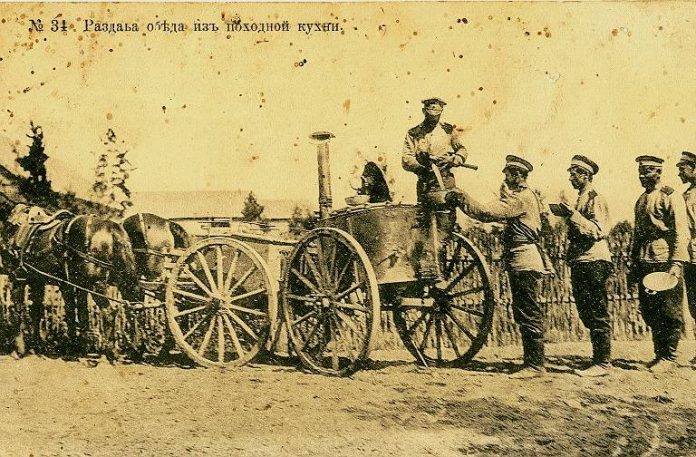
this period, approximately 1890 by 1910 years, It can be called a time of great change. maybe, a certain time period, and there was more change in the Russian army kitchen, but safely be called a period of difficult.
Of course, It played a huge role in the defeat of the Russian-Japanese War. After which even calloused Russian ministries scraped, but began a change. And these changes were so many ... But, judge for yourself.
canned goods
Yes, Army food in the form of canned meat firmly entered into the everyday life of the Russian soldier is in the Russian-Japanese war.
But, the most interesting thing in this story is, that was not a conservative domestic! Russian production of canned Azibera factory, What is going to talk previous articles, the war simply did not get.
Of course, certain stocks in the fortress were made before the war. But they were made, as well and ended, when the fortress of the village under siege by all the rules. Normal realities of war.
There is one more nuance. The capacity of the railways of the time. To deliver something in Port Arthur, it was necessary to (cm. map) drag car on the Trans-Siberian railway to Harbin, and there is a Port Arthur and Dalny (until capture threads Japanese) or to Vladivostok and then by sea.
Of course, Rail capacity at that time were small. And there were always more important loads, rather than stew. ammunition, ammunition, rifles, etc..
So canned, which were delivered by sea to Port Arthur, It was American ...!
Yes, It proved more profitable and faster to buy canned Party in the United States and the sea, under neutral flags, deliver to Port Arthur. Of course, in spite of the delivery of the sea, canned still not enough, and history has preserved evidence, soldiers prepared pound jar canned meat for three.
But the bank for three still significantly better, than nothing.
With regards to canned, in those years it was introduced by the so-called "hold time". Aziber, as the manufacturer, who needs: a) sell and b) quickly, resisted, how could, but the Russian Defense Ministry insisted that, all canned before shipment two weeks kept in warehouses.
During this time all the banks with inadequate sterilization usually swelled and exploded. So the rejection of the problem has been solved in such a way. AND, need to say, soldier, as the final customer, It was on hand.
And further. It was the military department insisted on a number of draconian measures simply to manufacturer. it, of course, It was arbitrary, that could only happen in a totalitarian empire (joke, if anything), but with 1901 year in factories, supplied the canned arsiyu, introduced measures such as "sex sprinkling of fresh wood shavings in the morning and evening", "Washing hands with soap or pine tar", "Mopping after use with soap and alkali". alkaline soap, as I understand, this is an analogue of modern economic, with a high content of alkali.
Floors with soap ... In 1901 year ... Just Chill.
Tea
Oddly enough, but tea conquered the Russian army even faster, than the nobility and the merchant class. Cunning quartermasters quickly realized, that tea is very easy to transport, it is easy that when you move, that in preparation.
remind, that the main drink of the Russian soldier until the tea was kvass. But cooking kvass - a question quite a long time, and boil kettle / samovar / pot of water, sypanut to brew - and all!
Before anything Russian army did not capitulate so quickly, both before tea. Tea Blitzkrieg ended in just a few years.
AT 1905 city, after the Russian-Japanese War, Order № 769 the Army had established a tea rations. The image and likeness of the English and Japanese armies.
The tea rations consisted of money, Lets go to buy tea and sugar. The day for the soldier / sailor sets the standard in 2 grams of tea and 25 grams of sugar.
Compared with the British soldiers did not spoil. In England, where tea was elevated to cult, They receive 2,5 kg of tea per year, and the British Navy sailor more 3. Russian soldier rations consisted of 735 grams of tea per year, but when compared with the usual life of the Russian people, it was more than luxurious.
And really such a thing, sugar, the vast majority of Russians from the provinces only in the army, and could try.
Although honey has not been canceled. Tea with honey is not worse than tea with sugar, but in military terms, of course, sugar stored easier and quicker to issue.
There were also funny moments. Sugar portion were given only nature and directly at the hands of soldiers, daily or every other day depending on the agility quartermasters. At tea it was possible to get money (can, thence, and went the term "to tip", i.e, it was a small amount of), but the sugar - no. hands only.
In this case, the full program nakosyachit soldiers, stints in the brig under strict arrest or reinforced, deprived and tea, i sahara. "Guba" really was not sugar. But trapped in the brig as usual, retains the right to tea with sugar.
Tea, as part of allowance, issued before 1905 of the year. But there were nuances. Tea has been a component of dry rations, i.e, issued when, when it was clear, that the soldiers will not get hot boiler supply.
Rather peculiar recognition of the value of tea, is not it? No hot cabbage soup with meat and porridge - if only for hot tea. It is also an option, as the saying goes.
Generally, at the beginning 20 century tea became as an integral component of military specialties.
Running ahead. FROM 1907 It has been included in the tea-things tea costs in the amount of allowances (mugs) and ... Coal samovars. Mugs and samovars officially became the subject of a soldier with items 1907 of the year.
These expenses accounted for by 5 cents per person per year. In this way, infantry company numbering 200 Man gets a year 10 rubles. With this money was supposed to buy aluminum or tin cups and sack (about 50 kg) coal for samovar.
food alignment
To describe the time settled another dimension, which I want to tell. Food rations to the Russian army 1906 g. It consists of three seemingly different (not really) parts:
1. Provision allowances.
2. Privarochnoe allowance.
3. tea rations (from 1905 city).
Provision allowances - those products, that the army quartermasters were to provide enlisted personnel on the established norms in kind. Prices of Provision allowances are set only once for a period of one to three years. In fact, it was not finished products, and raw materials, which could be stored for a long time, easily transported and so on.
The commissariat rations of bread were baked and flour, crackers, salt, groats and vodka.
issuing regulations do not actually changed with 1874 of the year, Yes, properly, and there was no need to change them.
Privarochnoe allowance - a slightly different kind of supply, For victuals was common only in monetary terms. These amounts were given unit commanders, mouth and squadrons on a daily hot meal lower ranks.
Subject to the reform, As for 1906 year money issued once a year, and then 1906 year they began to issue a quarterly basis, more precisely, in accordance with the seasons.
The bad news was that, that responsibility for the soldier power entirely attributed to the commanders. If the commander really was a "servant of the king, Father of a Soldier ", no problems. If not - to steal was a huge field.
The idea was not bad very: entrust commanders seasonal and spatial manipulation range and prices, to improve the supply of soldiers and administration according to the season in the soldier's diet more quality and cheap vegetables.
By the presence of vegetables in the diet of Russian soldiers departed from the French ally, almost five times. However, the imposition of duties on officers Catering soldiers has become a huge negative factor, virtually uncontrollable.
Virtually power soldier was again entrusted the officers, or, as they were called, fathers-commanders, that is made dependent on the subjective, not giving any account, or control factors.
Honestly, in my humble opinion, tupili in the military from the heart. Generals and admirals did not want to understand, that the output, Bright and cheery, he is near. In a regiment or brigade dining, at a time where you can feed the soldiers.
Surprisingly, but in the beginning 20 century in the Russian Defense Ministry considered, that the organization supply troops so, at the regimental level, troublesome and unprofitable.
Of course, obviously it was easier to give "victuals" money, and then let the company and platoon headache, how to make money on the food for its soldiers.
It seems to be reform, but in fact - is not very. Not the case officer to run on the markets, purchasing products for men. And no matter the soldier to sit and wait, until all srastetsya. output was, but alas!, tsarist generals stubbornly refused to even knock on him.
And it would be necessary, because the potential was. We had to just implement it. We can not say, that the nutrition we trailed in the wake of the "civilized Europe".
bread norm, Lets go to the soldier in the Russian army, It was the highest in the world. It was believed, that Russian soldiers had to eat in a day 1 028 g. baked bread, and in Germany and in France, the local soldiers received only 750 g.
At the same time Russian soldiers ate black, natural rye bread, rich in vitamins and more nourishing, and European soldiers received only wheat white bread, which Russian was considered too "flimsy" or "manor".
Along with bread, on one Russian soldier had about a year 50 kg of cereals. Buckwheat, spelled, perlovka. Porridge, as we have said, it is not steamed vegetables evroratsione.
Revisiting the welding of. This historical piece.
Victuals - is sacred, and that's why. If compulsory rations in the form of bread and cereals, It can be replaced, depending on the circumstances of flour, breadcrumbs, or (eg) corn or grain, then included the victuals, that diversity soldier table. Meat, fat, butter, vegetables, pepper and especially - wheat flour for soups podboltki for the purpose of thickening.
Even a very strong German canned meat broth was considered the "little water" Russian soldier, as it was almost transparent. What to say about the European soups that time? General on the topic of nutrition in foreign armies is better to read the Marshal of the Soviet Union, Twice Hero of the Soviet Union, Rodion Malinovsky. In the book "Soldiers of Russia", which is present on the Internet.
The system also Russian welding, to command any part of the case was troublesome, but profitable. Yes there, most advantageous! After all, it was possible to manipulate the way, as you please, buy meat of inferior quality, third, so to speak, varieties. And the vegetables could get stale and poduvyadshie. What, soldier - he eats!
But quantitative welding rates were higher in the Russian army, than Europe. The daily delivery of meat to the Russian soldier was established in the early 20th century 307 g, while the French - 300, but the Germans 180 g meat and 26 g fat, Austrians 190 g meat and 10 g lard.
However, in all foreign armies the size of assets, take-out food rations, commensurate not only with local prices, but also with food and cooking conditions depend on the actual troop movements, when the power is abruptly intensified.
In the Russian army allowance on victuals determined once and for all in the year. Until all was quiet, nobody worried. But after the defeat in the Russian-Japanese war began, inflation and its attendant price fluctuations. They almost destroyed the high welding standards in the Russian army, turning everything into fiction.
Well, naturally, is a normal phenomenon for Russia - embezzlement. All, who could snatch from the soldier's diet, certainly did.
Generally, reform 1905-1906 s was in fact not such a reform. System seems to be improved from the heart, Rada of soldier, but actually went out again zero. One side, war in faraway Manchuria showed, that the Achilles heel of the Russian army - it's supply and catering, on the other - all with a few exceptions remained in their places.
And one moment, that I would like to voice. Moving troops.
clear, that in those years the troops moved on the roads and paths. And stops preferred in settlements, but not among the vast expanses.
And then in effect for the traditional Russian "allowance of inhabitants" when moving troops. regulate, but nonetheless.
Allowances from the inhabitants could enjoy only the lower ranks, single or small team of abnormal following step. townsfolk, that is, the owners of the cottage, We had to feed overnight stays at war twice - once in the evening on arrival at night and once in the morning on speech.
During the arrest the so-called day of rest, the number of mandatory feedings increased to four: one on arrival for the night, two during the daylight hours, and one morning, when speaking on the following day from the locality.
Payment of the subsistence allowance of the lower ranks had to bear the treasury, paying the corresponding receipt on official standards at the rate of 20-25 cents per day.
Wait officers is a matter of individual, and, respectively, also paid for separately.
In general it can be said, the lessons, which caused the Russian army Russian-Japanese War, Not that were not in vain, no. But, in the words of a classic, «hotels, how best, it turned out as usual ".
It seems that the reform pursued the only goal of improving nutrition, but in fact all the same archaic solutions. But do not dismiss such a breakthrough, as canned food in a soldier's diet and field kitchens, the first step on the soldiers' side of the boiler in modern power system.
reforms 1905-1906 s can be assessed as "satisfactory". by the way, the same evaluation reaffirmed the First World War, who was standing on the doorstep.











